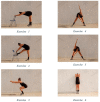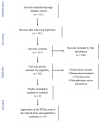Efficacy of Physiotherapy Treatment in Primary Dysmenorrhea: A Systematic Review and Meta-Analysis
- PMID: 34360122
- PMCID: PMC8345570
- DOI: 10.3390/ijerph18157832
Efficacy of Physiotherapy Treatment in Primary Dysmenorrhea: A Systematic Review and Meta-Analysis
Abstract
Primary dysmenorrhea (PD) refers to painful cramps before and/or during menstruation. There is a need for emphasis on alternative methods of conservative treatment, so as to reduce the dependence on drugs for alleviating the symptoms. The aim was to find out the effectiveness of some physiotherapy techniques in the treatment of PD. A systematic review and meta-analysis was conducted according to PRISMA standards. The descriptors were "dysmenorrhea", "physical the-rapy", "physiotherapy", and "manual therapy". The search was performed in five databases: Scopus, PubMed, PEDro, Web of Science, and Medline, in February 2021. The inclusion criteria were randomized controlled trials over the last six years. Articles not related to the treatment of PD or using pharmacology as the main treatment were excluded. Nine articles met the objectives and criteria, with a total of 692 participants. The most used scale to measure pain was the VAS (visual analogue scale). The main techniques were isometric exercises, massage therapy, yoga, electrotherapy, connective tissue manipulation, stretching, kinesio tape, progressive relaxation exercises and aerobic dance. Meta-analysis shows benefits of physiotherapy treatment for pain relief compared with no intervention or placebo (MD: -1.13, 95% CI: -1.61 to -0.64, I2: 88%). The current low-quality evidence suggests that physiotherapy may provide a clinically significant reduction in menstrual pain intensity. Given the overall health benefits of physiotherapy and the low risk of side effects reported, women may consider using it, either alone or in conjunction with other therapeutic modalities.
Keywords: electrotherapy; manual therapy; pain; physical therapy; primary dysmenorrhea.
Conflict of interest statement
The authors declare no conflict of interest.
Figures
Similar articles
-
Spinal manipulation for primary and secondary dysmenorrhoea.Cochrane Database Syst Rev. 2001;(4):CD002119. doi: 10.1002/14651858.CD002119. Cochrane Database Syst Rev. 2001. Update in: Cochrane Database Syst Rev. 2004;(3):CD002119. doi: 10.1002/14651858.CD002119.pub2. PMID: 11687141 Updated.
-
Herbal and dietary therapies for primary and secondary dysmenorrhoea.Cochrane Database Syst Rev. 2001;(3):CD002124. doi: 10.1002/14651858.CD002124. Cochrane Database Syst Rev. 2001. Update in: Cochrane Database Syst Rev. 2016 Mar 22;3:CD002124. doi: 10.1002/14651858.CD002124.pub2. PMID: 11687013 Updated.
-
Massage, reflexology and other manual methods for pain management in labour.Cochrane Database Syst Rev. 2018 Mar 28;3(3):CD009290. doi: 10.1002/14651858.CD009290.pub3. Cochrane Database Syst Rev. 2018. PMID: 29589380 Free PMC article.
-
Yoga for chronic non-specific low back pain.Cochrane Database Syst Rev. 2022 Nov 18;11(11):CD010671. doi: 10.1002/14651858.CD010671.pub3. Cochrane Database Syst Rev. 2022. PMID: 36398843 Free PMC article.
-
Transcutaneous electrical nerve stimulation and acupuncture for primary dysmenorrhoea.Cochrane Database Syst Rev. 2002;2002(1):CD002123. doi: 10.1002/14651858.CD002123. Cochrane Database Syst Rev. 2002. PMID: 11869624 Free PMC article.
Cited by
-
Safety and efficacy of therapeutic taping in primary dysmenorrhea: a systematic review and meta-analysis.Sci Rep. 2022 May 3;12(1):7146. doi: 10.1038/s41598-022-11034-w. Sci Rep. 2022. PMID: 35504906 Free PMC article.
-
Effects of Sacroiliac Joint Manipulation on Autonomic Nervous System and Lower Abdominal Pain in Women with Primary Dysmenorrhoea: A Randomized Controlled Trial.Medicina (Kaunas). 2024 Dec 16;60(12):2068. doi: 10.3390/medicina60122068. Medicina (Kaunas). 2024. PMID: 39768946 Free PMC article. Clinical Trial.
-
Efficacy of Connective Tissue Therapy and Abdominal Stretching Exercises in Individuals With Primary Dysmenorrhea: A Review.Cureus. 2023 Oct 5;15(10):e46553. doi: 10.7759/cureus.46553. eCollection 2023 Oct. Cureus. 2023. PMID: 37933353 Free PMC article. Review.
-
Acute effects of virtual reality-based relaxation and exergaming on primary dysmenorrhea symptoms.Turk J Med Sci. 2025 Feb 27;55(2):377-385. doi: 10.55730/1300-0144.5981. eCollection 2025. Turk J Med Sci. 2025. PMID: 40342331 Free PMC article. Clinical Trial.
-
Transcutaneous Tibial Nerve Stimulation for Primary Dysmenorrhea: A Protocol for a Randomized Controlled Trial.Healthcare (Basel). 2023 Jun 2;11(11):1633. doi: 10.3390/healthcare11111633. Healthcare (Basel). 2023. PMID: 37297773 Free PMC article.
References
-
- García Hurtado B., Chillón Martínez R., Rebollo Roldán J., Orta Pérez M.A. Dismenorrea primaria y fisioterapia. Fisioterapia. 2005;27:327–342. doi: 10.1016/S0211-5638(05)73458-1. - DOI
Publication types
MeSH terms
LinkOut - more resources
Full Text Sources
Medical
Miscellaneous







